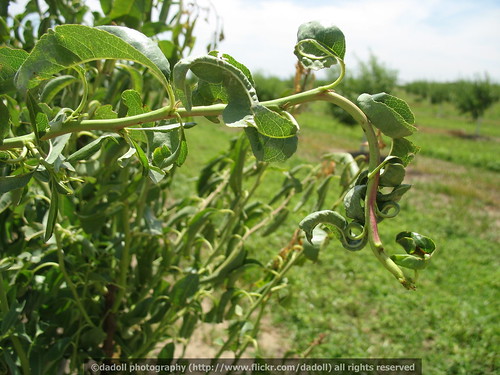Herbicide drift damage to a Butte/Padre almond orchard by 2,4-D
May is the time of the year for the herbicide injury to almonds. High winds, fast growing weeds, and too many orchard tasks to complete in a day are the typical causes of herbicide drift. Herbicide drift can be prevented by following a few simple principles:
1). Avoid windy days when applying herbicides,
2). Apply the correct herbicide that targets the correct weed,
3). and apply the herbicide at the proper rate.
A field call in mid-May by a grower yielded a case of typical 2,4-D injury to almond. The 2nd leaf orchard was 50% Butte and 50% Padre on nemaguard rootstock. The orchard was situated in sandy soil with microsprinklers used for irrigation. The grower reported multiple trees showing dieback of new growth. He was uncertain of the cause and thought verticillium wilt may be affecting his orchard. Picture 1 shows the overall symptoms of an affected almond tree.
Picture 1: Overall tree symptoms caused by 2,4-D herbicide drift. Note tip dieback and odd growth.
Overall, the distribution of the symptoms were found throughout a large percentage of the block. Many trees where showing a "shepherd's crook" of the new growth indicating either a wilt disease or herbicide/salt issue. Picture 2 shows the severity of the symptoms on the new growth of the almond tree.

Picture 2: Branch tip dieback due to 2,4-D herbicide drift.
Leaves at the tip of the crook were crispy, indicating a fast wilt. Shoots with contorted growth were found throughout the canopy. Pictures 3 and 4 are of these symptoms.

Picture 3: Branch damage from 2,4-D herbicide drift. Branch is showing the "shepherd's crook" symptom, typical of vascular wilt pathogens or salt/chemical damage.

Picture 4: Contorted growth of new growth caused by exposure to 2,4-D herbicide.
With the exception of the contorted growth, symtpoms expressed by the affected trees could be one of four possibilities which include verticillium wilt, nitrogen burn, peach twig borer (insect damage), or herbicide injury. Verticillium wilt is characterized by vascular staining and can be checked by cutting into the tissue of the affected branches. Peach twig borer is caused by an insect and tends to affect new growth, but typically does not cause crispy leaves. I was unsure about the possibility of nitrogen burn, but the grower was open with information relevant to his recent applications of nitrogen. He applied roughly 1.5 ounces per tree of straight nitrogen, which is an amount that would not cause burn on 2nd leaf trees. Knowing this, only one option remains - the cause which I suspected due to the contorted growth of the branches.
The herbicide used within the orchard was 2,4-D. When asked about application procedures, the grower said he hand gunned on the herbicide and applied it at the high end of the label rate. While hand-gunning of herbicide provides the ability to spot treat areas, it typically leads to over application of herbicides within the treated area. Furthermore, even though 2,4-D works well on most weeds, it has the ability to translocate within plants if it is somehow taken up by the plant. I suspected that this was the case with these trees.
I noted within the orchard that the damage to the trees looked related to a high weed kill around the base of the tree. Closer inspection of the tree trunks within these areas revealed several cracks in the bark at the ground level - probably cracks caused by the tree moving in the breeze. Inspection of the leaves of these trees also indicated damage caused by herbicide drift. It is unsure of whether or not the herbicide entered the tree through the trunk or the leaves, but it was clear that a sufficient amount of herbicide had the opportunity to enter the tree.
I advised the grower to be more careful with his subsequent herbicide applications. In mentioning the principles above, I placed emphasis on the proper application rate and avoiding windy days.

